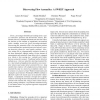Free Online Productivity Tools
i2Speak
i2Symbol
i2OCR
iTex2Img
iWeb2Print
iWeb2Shot
i2Type
iPdf2Split
iPdf2Merge
i2Bopomofo
i2Arabic
i2Style
i2Image
i2PDF
iLatex2Rtf
Sci2ools
ICDM
2008
IEEE
2008
IEEE
Discovering Flow Anomalies: A SWEET Approach
Given a percentage-threshold and readings from a pair of consecutive upstream and downstream sensors, flow anomaly discovery identifies dominant time intervals where the fraction of time instants of significantly mis-matched sensor readings exceed the given percentage-threshold. Discovering flow anomalies (FA) is an important problem in environmental flow monitoring networks and early warning detection systems for water quality problems. However, mining FAs is computationally expensive because of the large (potentially infinite) number of time instants of measurement and potentially long delays due to stagnant (e.g. lakes) or slow moving (e.g. wetland) water bodies between consecutive sensors. Traditional outlier detection methods (e.g. t-test) are suited for detecting transient FAs (i.e., time instants of significant mis-matches across consecutive sensors) and cannot detect persistent FAs (i.e., long variable time-windows with a high fraction of time instant transient FAs) due...
| Added | 30 May 2010 |
| Updated | 30 May 2010 |
| Type | Conference |
| Year | 2008 |
| Where | ICDM |
| Authors | James M. Kang, Shashi Shekhar, Christine Wennen, Paige J. Novak |
Comments (0)

